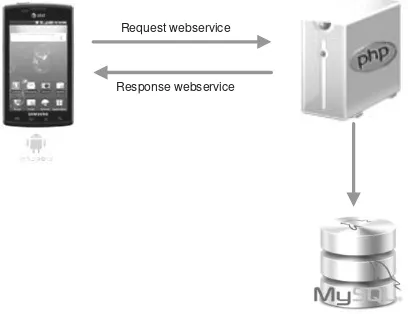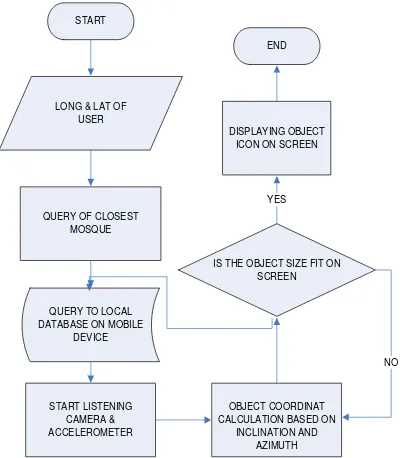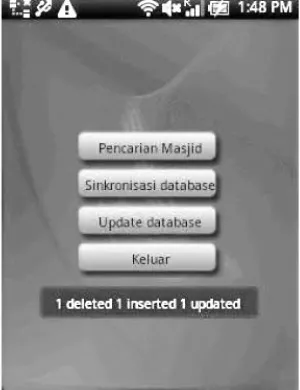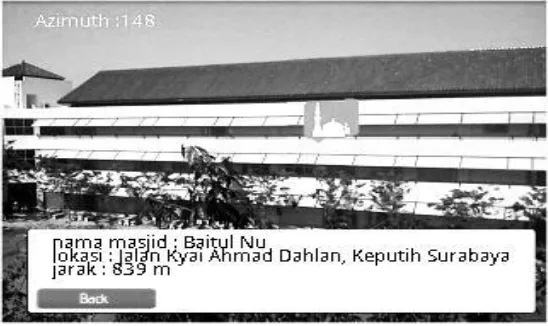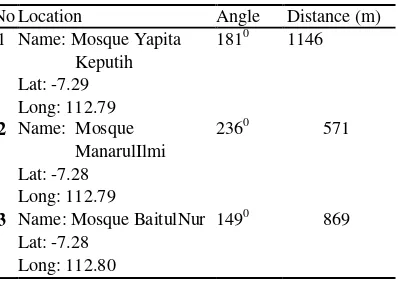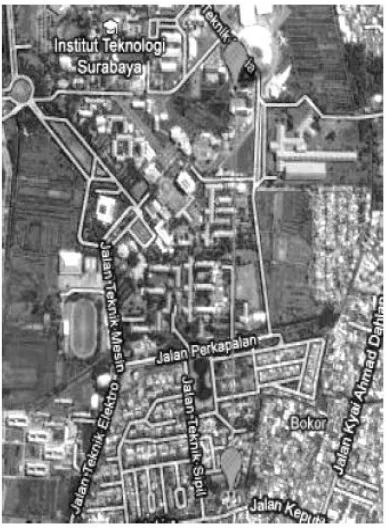AUGMENTED REALITY ON ANDROID OPERATING
SYSTEM-BASED DEVICE;CASE STUDY: MOSQUE FINDER
a
AryMazharuddinS,
bDiaz Hendrianto
a,b
Department of Informatics, Sepuluh Nopember Institute of Technology Jln Raya ITS, Sukolilo, Surabaya, 60111
E-Mail:[email protected]
Abstrak
Augmented Reality (AR) telah menjadi salah satu trend penelitian dalam hal pemanfaatan pemodelan objek secara virtual. AR bekerja dengan memodelkan objek yang ada pada dunia nyata ke dalam dunia virtual dengan memanfaatkan piranti input. Piranti input yang dimaksud dapat berupa kamera, sensor, atau bahkan GPS. AR dapat bekerja secara real time dengan menampilkan pergerakan dari objek nyata dengan perwujudan model objek pada layar monitor. Penelitian ini mengembangkan Augmented Reality untuk pencarian lokasi masjid. Augmented Reality (AR) adalah teknologi yang menggabungkanobyek dua dimensi virtual ke dalam lingkungan tiga-dimensi kemudian menampilkan obyek virtual secara real-time. Untuk menerapkan konsep AR, aplikasi ini menggunakan sensor terpadu seperti accelerometer, kompas dan Global Positioning System (GPS).Lokasi masjid dapat didownload dari serverkhususdan disimpan dalam smartphone. Untuk mengantisipasi jika terdapat data baru pada database, aplikasi ini juga dilengkapi dengan fitur sinkronisasi dengan menggunakan layanan web dengan teknologi XML. Hasil percobaan menunjukkan bahwa pencarian lokasi masjid dapat dilakukan dengan lancar dengan teknik augmented reality. Rincian lokasi masjid dapat secara akurat ditampilkan pada perangkat ditangani.
Kata kunci: Augmented Reality, GPS, Accelerometer.
Abstract
Augmented Reality (AR) has become one of research trends in the utilization of virtual object modeling. AR works by modeling objects that exist in the real world into a vitual world by using input devices. The input devices can be a camera, sensor, or even GPS. AR can work in real time fashion to show the movement of a real object by using a form of model shown at monitor screen.This research developed an Augmented Reality for locating a mosque. Augmented Reality (AR) is a technology that combines two-dimensional virtual object into a three-dimensional environment then displays the virtual objects in real-time fashion. To implement the AR concept, this application uses integrated sensors such as accelerometer, compass and Global Positioning System (GPS). The location of mosques are downloaded from a dedicated server and stored in asmartphone. In order to anticipate should there is an update of data at the database; this application is also equipped with synchronization feature using a web service with XML technology. Experiment results show that the mosques location searching can be performed smoothly with the augmented reality technique. The details of the location of the mosque can be accurately displayed at the handled device.
INTRODUCTION
very difficult especially for people from outside of an area to find the location of the mosque [1].A modern method to find an address is based on Geographical Information System (GPS) applications. This application displays the information in the form of digital maps along with the image path and routing to arrive to the destination.
Augmented Reality is a technology that combines two-dimensional virtual object and three dimensional or in a real three-dimensional environment and then projecting the virtual objects in real-time manner [2]. Virtualobjects display the information in the form of a label or virtual objects that can only be seen with a camera phone or a computer [3]. Augmented Reality system works by analyzing a real-time object captured in the camera. By the use of rapid development of mobile technologies, Augmented Reality can be implemented on devices that have GPS, camera, accelerometer and compass [4]. The combination of the three sensors can be used to give additional real, and an introduction to the crucial problem of registration, including sources of registration error and error-reduction strategies [5, 6]. While Feiner, S., et. al. discussed about AR based on knowledge that graphics and text that present on surrounding world can be used to how to operate, maintain, or repair equipment, without referring to a seperate manual books [7].
In this paper we designed and implemented Augmented Reality technology on android based mobile application to find location of mosque. Location of the mosque that was caught in camera will be labelled with distance information, the mosque's name and description of the mosque.
INCORPORATING GPS,
ACCELETOMETER, AND GOOGLE
MAPS
In order to implement the system, this researh uses sensors implanted in recent smartphones, i.e. accelerometer, compass and Global Positioning System (GPS). The accelerometer is used to detect should the is a movement of the smartphone, in terms of its axis and ordinate. The data is then used to calculate the
display of objects to search on smartphone’s
screen. The compass is used to show directions of the map, and the GPS is used to tag the location of a user. The data obtained from GPS is used to calculate distance from the user’s current location and a mosque. Then, it is used to find shortest path to travel to a selected mosque. The route can also be displayed on map along with the shortest path.
AUGMENTED REALITY
ARCHITECTURE
By implementing a client-server system on the network, the client application can update database in and out of the server. Data retrieved from the server mosque then stored in internal storage media for mobile phones. In general, the architecture of the system is shown in Figure 1.
This process performs calculations to obtain the coordinates of the mosque to be shown on mobile devices. As the data of longitude and latitude of a mosque is stored in a database located on mobile devices, thus the calculation takes less time to finish. The calculation procedure is shown at Figure 2.
Request webservice
Response webservice
START
Figure 2. Flowchart Calculation of Augmentedreality.
Figure 3. Illustration of Azimuth Angle.
Figure 4. Accelerometer in Android Device.
Calculation of The Azimuth Angle
In a common navigation system, there is the term azimuth, which is the angle between magnetic north (zero degrees) to the destination that we are headed relatively to the northern continuously to enable the system to display the position of the mosque on the screen when the user moves the mobile device.
Calculation of The Angle of Inclination
Vertical angle of inclination angle is formed between the location of the user and the location of the mosque. This can be cone using a GPS point elevation. Having obtained the height of each point, the next step is to determine the vertical angle between two points using trigonomteri formula. By reading the accelerometer sensor on mobile phone, each mosque will be displayed on the screen based on the angle of the mobile device screen and the coordinate of each mosque. X-axis represents horizontal line, Y-axis represents vertical and the Z-axis represents the distance of the mosque. An accelerometer in android is shown in Figure 4.
Android capture accelerometer sensors on 3 sets (m/s2):
Value [0]: the value of the x-axis accelerometer Value[1]: the value of the y-axis accelerometer Value [2]: the value of the z-axis accelerometer
RESULT AND DISCUSSION
The experiment was conducted using a mobile device with the following specifications
Name : Sony Ericsson Xperia x10 mini Processor : 600 MHz
Connection : 3G
OS : Android v2.1 (Eclair)
Figure 5. Searching a Mosque.
Figure 6. Listing Nearby Mosques.
Figure 7. Inserting/Modifying a Mosque Data.
Figure 8. Deleting a Mosque Data.
Figure 10. Search Trials Mosque Yapita.
Figure 11. Search Trials Manarul Ilmi Mosque.
Accelerometer sensor to calculate the acceleration sensed from the device. In this sensing mechanism, the gravity influences the values produced by the accelerometer sensor. Thus, to obtain the accurate value of the movement, the values produced by the sensor needed to be filtered first. This research uses high-pass filter to remove the gravity influence. The next step is to change the value in the units of degrees, where the value 900 is located at the horizontal axis, the value of 450 is at a half up / down, and 00 in a straight line up / down.
Functionality Experiment
This experiment aims to verify the functionality of each feature of this application. The functions tested in this experiment are:
1. Searching location of a particular Mosque (Figure 5). When searching a mosque, the application displays the result on the screen with additional information (name of the mosque, distance, and short description).
2. Listing nearby Mosques (Figure 6). This function displays the closest mosques to the location of the user.
3. Inserting, deleting, and updating Mosque data (Figure 7). This function enables the user to modify the content of the database.
4. Synchronising Mosque database (Figure 8). To keep the mosque updated, this application synchronises its database with the server, either manually or periodically. Should the process is successful, the report will be displayed as shown in Figure 9.
Performance Experiment
This experiment aims to measure the accuracy of digital compass for locating mosques. This experiment scenario is performed by comparing the calculated azimuth angle obtained from the application with the calculated azimuth angle obtained using the azimuth angle as shown in Equation (1).
... (1)
Ø1 = Latitude at position 1, Longitude zero Ø2= Latitude at position 2, Longitude L
(positive eastward) α = Azimuth
The first experiment used the azimuth angle calculation equation. This calculation is implemented with javascript programming language. In this experiment, the user location is selected using the Google Map location coordinates as follows:
Latitude : -7.27 Longitude : 112.79
while the Mosques used for the experiments are shown in Table 1.
Table 1. Azimuth Angle Calculation Result.
No Location Angle Distance (m)
3 Name: Mosque BaitulNur Lat: -7.28
Long: 112.80
1490 869
Then, the location of the mosques can be displayed on map. The map produced is
labelled with direction line from user’s location
to the mosque along with the distance. The map of each direction is shown at Figure 13 – 15.
Based on the observations of the experiment results, the digital compass embedded in the device has a high degree of accuracy. This is concluded by comparing the manual calculation of azimuth with the azimuth calculation performed by the mobile device, using trigonometric equations, that is only 1, 6 0 difference. In addition, the mosque icon the the screen is able to adjust to the movement of the device in a real time fashion.
CONCLUSION
Figure 13. Direction to Mosque Yapita Keputih.
Figure 14. Direction to Mosque ManarulIlmi.
Figure 15. Direction to Mosque BaitulNur.
REFERENCES
[1] Ambarwati L and Fariza A. Geographic information systems worship places in Surabaya. Final Project Report. 2010. URL: http://digilib.its.ac.id/ Call Number:RSEP 025.04, accessed on June 20, 2011.
[2] Sung-Hyun J and Andrew H. GIS and Augmented Reality in 2015. The UK geospatial industry in 2015. Association for Geographic Information Expert Paper. 2010. URL: http://www.agi.org.uk/, accessed on February 5, 2011.
[3] Chien-Huan C, Chien-Hsu C, and Tay-Sheng J. An Interactive Augmented Reality System for Learning Anatomy Structure. Proceedings of the international multiconference of engineer and computerscientist (IMECS). 370-375. Hongkong. 2010.
Intelligence (AmI-09). 203-206. .Salzburg, Austria. 2009.
[5] Ronald T and Azuma R. A Survey of Augmented Reality. Teleoperators and Virtual Environments. 6:355-385. 1997.
[6] Azuma R, Baillot Y,Behringer R, Feiner S, Julier S, and MacIntyre B. Recent
advances in Augmented Reality. IEEE Trans on Computer Graphics and Applications. 21:34-47. 2001.
